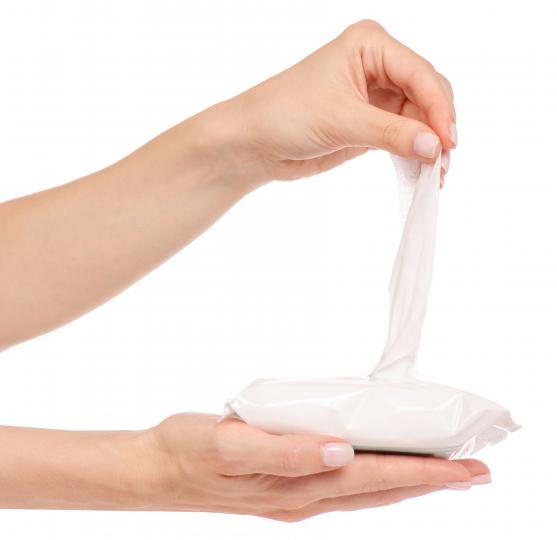Household Products
Flushable Wipes Market to Reach $3.5 Billion By 2023
Hydroentangled wetlaid nonwovens now dominate the flushable wipes market.
Published
6 years agoon
By
BXP Reader
(PRESS RELEASE) Demand for convenience and hygiene is driving the rapid growth of a flushable wipes market that will be worth $3.5 billion by 2023, according to a new market study from Smithers Pira.
In 2018, flushable wipes account for $2.1 billion in sales, and consume 1.9 billion square meters or 98,900 tons of nonwovens. This is up from $1.2 billion, and 1.1 billion square meters or 57,200 tons in 2013. Projections are for sales of $3.5 billion, 3.6 billion square meters or 182,900 tons by 2023, according to The Future of Flushable Wipes to 2023 report.
The report considers all wipes labelled and sold as “flushable” wipes. These are primarily two major types: flushable by size and compliant with INDA/EDANA’s Guidance Document for Assessing the Flushability of Nonwoven Disposable Products – version 3.
The sale of flushable wipes is driven by convenience, hygiene, performance, cost and consumer eco-perception. The selection of nonwoven substrates for flushable wipes is driven by concerns about current and potential regulations. Since 2015, there has been an adequate supply of dispersible nonwovens for flushable wipes; in 2018, there is an oversupply globally.
For important flushable wipe types, like adult moist toilet tissue, toddler toilet care and feminine hygiene wipes, the combined convenience of disposal (in the location where used) with the hygienic removal of the soiled wipe immediately from the household, is a major purchase driver. Nevertheless, the consumer has demonstrated that the labelling of a poor-performing or expensive wipe with “flushable” or “biodegradable” is not enough to drive sales. But for equal-performing and value products, biodegradability is perceived by the consumer as a desirable attribute.
About 85 percent of all nonwovens used for flushable wipes in 2018 are INDA/EDANA guideline-compliant dispersible nonwovens; by 2023 this will increase to about 97%. This increase in INDA/EDANA guideline-compliant nonwovens is due to an unprecedented expansion of such nonwoven capacity in the 2015–18 period, including: new hydroentangled wetlaid, spunlace lines and hybrid process (“other”) lines. In 2018, total dispersible nonwovens capacity for flushable wipes exceeds demand by about a 2:1 ratio.
AdvertisementThere are two major developments that have affected the use of raw materials for flushable wipes in the last three years: flushable by size wipes have almost completely disappeared from the market and hydroentangled wetlaid nonwovens now dominate the flushable wipes market.
The first of these developments, the disappearance of flushable by size wipes, has almost eliminated non-biodegradable materials from the flushable wipes market – these represented almost 20% of materials used in 2015; in 2018 this is 6.8%.. The second development, the new dominance of hydroentangled wetlaid, has led to increasing usage of wood pulp and rayon/lyocell.
The continued phasing-out of all non-dispersible nonwovens used in flushable wipes over the next few years will increase this percentage even further. By 2023, only 1.9 percent of all raw materials used in flushable wipes will be non-biodegradable.
In Western Europe, seven countries/regions – the UK, Germany, France, Italy, Spain, Benelux and Scandinavia – account for about 85 percent of the flushable wipes market there in 2018. In Eastern Europe, Russia, Poland and Turkey account for 80% of the flushable wipes market there in 2018. In North America, the US and Canada represent almost 95% of the flushable wipes market for the region in 2018. In Asia, China, India and Japan represent about 85 percent of the regional market for flushable wipes. The rest of the world, or ROW, is mainly Middle Eastern and African countries.
For the five years to 2023, in a reversal of fortunes from only a few years ago, Eastern Europe will see dramatically lower growth at 6.2 percent, followed by South America down to only 8.9 percent. Western Europe will be at 7.3 percent. Since the average growth rate for sales dollars from 2018–23 for flushable wipes is 11 percent, all of these regions are set to grow at below-average rates. Only Asia (18.7 percent), North America (11.2 percent) and the rest of the world (11.6%) are forecast to grow at above-average rates.
The Future of Flushable Wipes to 2023 is based on extensive primary and secondary research. Primary research included interviews with key participants in the entire wipes supply chain. Key participants interviewed included personnel from branded wipe producers, private label producers, nonwoven substrate producers, raw material suppliers and general industry experts. Secondary research included in-depth analysis of information acquired from technical literature, market reports, papers, conference proceedings, company information, and other trade, business or government sources.
AdvertisementSend your press releases to BXP at press@bxpmagazine.com. Learn about our submission guidelines.

SPONSORED VIDEO
Branding with Ferocity – Thinking Like an Indie Brand
Get a better understanding on how to leverage new technologies to engage and delight shoppers, sustainability’s role in product and package design – being sustainable and premium are not mutually exclusive, plus best practices and tips for collaboration and how to launch new products and refresh existing product line-ups and brands.
You may like
Advertisement

GO MINIMALISM . . . HOLD ON A MINUTE!
Sustainable, 100% Recycled Transparent Sheeting is Now a Reality!

Kroger, Walgreens to Dedicate Section of Their Stores to Reusable Packaging

6 Marketing Tips for Ecommerce Brands to Win the Holiday Shopping Season

New Wunderoots Branding Celebrates the Carrot

Fact or Fiction? The Truth about Eco-Friendly Packaging

BXP May 2021 Think & Clink

Unilever Raises Bar for Accessibility with Degree Inclusive

Crown Royal’s Limited-Edition Pack Designed by Oscar-Winner

Coca-Cola Explores World of Paper Bottles
Subscribe

BULLETINS
Get the most important news and business
ideas from BXP Magazine's news bulletin.
Latest Tweets
Advertisement


